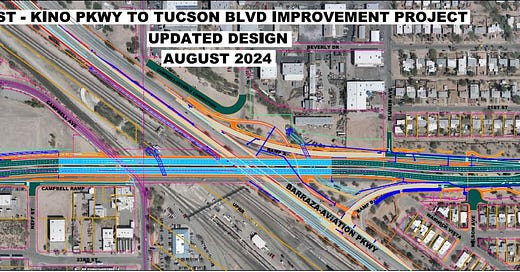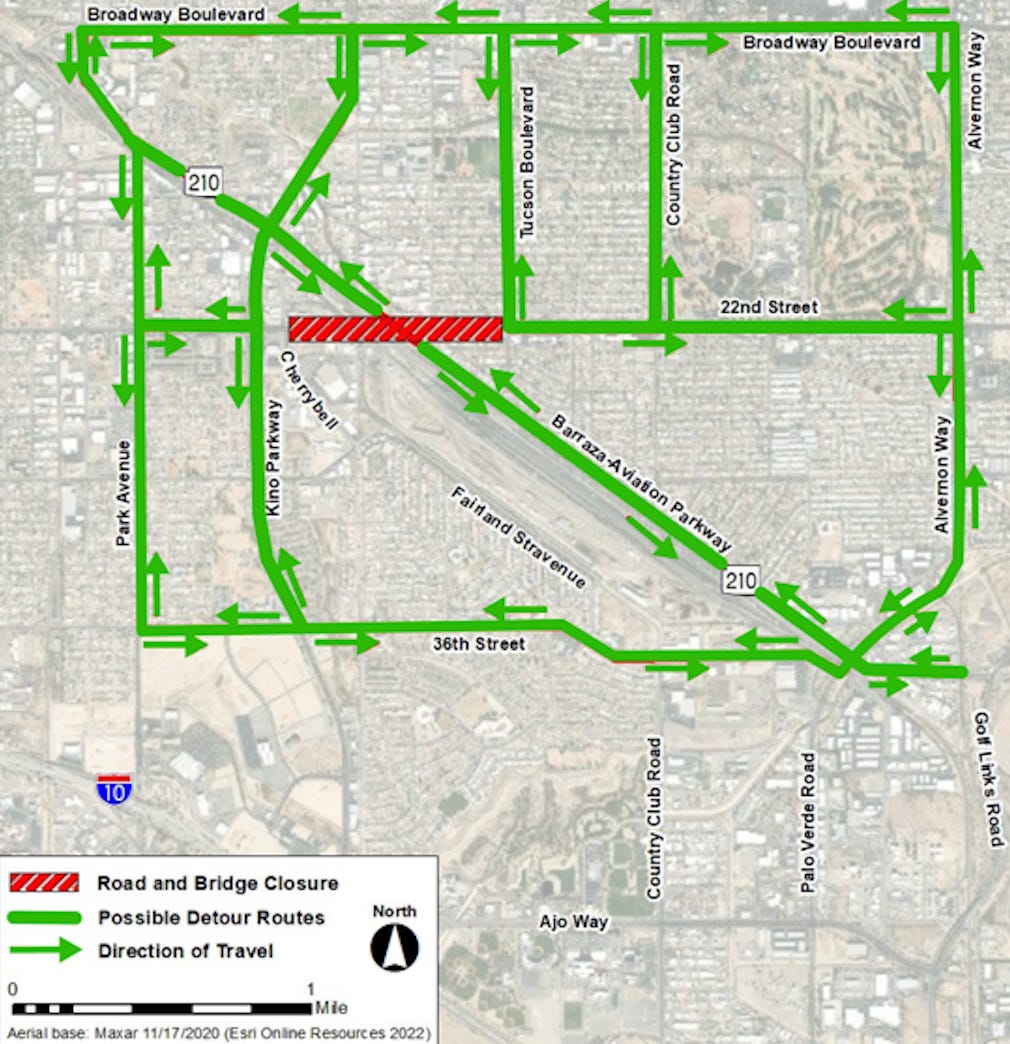Caught in the crossfire
It's just a bridge … No one wants the courthouse study … And what's the best Democratic tattoo?
If you wanted a poster child for a local project being held up for no other reason than national politics, look no further than the 22nd Street Bridge Revitalization Project.
It’s boring. Most people agree the bridge needs to be replaced. The city isn’t trying to make it a DEI project or turn it into walking trails for animal crossings. There is literally nothing about it that would offend the MAGA crowd.
But its funding is in limbo. At least for the time being.
For more than two decades, city planners have been actively discussing plans to replace the nearly 60-year-old 22nd Street bridge over the Union Pacific Railroad lines east of Campbell Avenue.
In fact, voters approved funding for the project way back in 2006, when they approved the Regional Transportation Authority. There were a few regulatory setbacks, along with a lot of arguing over the details of what the new bridge should look like, and it’s still not done.
2025 was supposed to be the year the city moved forward with the project, starting with demolishing the existing bridge. City planners still expect to formally solicit bids for the estimated $111 million project1 next month.
But it might not get much further than that in the current political climate. City officials are trying to work out whether $25 million in congressionally approved federal funding will be a reality by the time they get around to spending it.
The Federal Highway Administration (FHWA) has not approved the grant yet, city officials confirmed on Thursday to the Tucson Agenda.
While grant approvals can take months to get processed, the city would have no way of knowing whether the funding for this project is on hold due to recent executive orders signed by the Trump Administration.
The “shovel ready” 22nd Street Bridge project is one of six federal grant-funded projects the city of Tucson has put on hold as it waits for political battles to end and court challenges to proceed.
We’re not trying to minimize the years of community discussions that brought the project to its current state, but replacing the bridge itself is not particularly controversial. The need to demolish and replace it has been widely accepted for decades.
To extend the lifespan of the 59-year-old bridge, the city repeatedly lowered the weight limit and it is now at the point that city fire trucks and other heavy vehicles have to drive around the midtown bridge, instead of going over it.
In their grant application to the U.S. Department of Transportation, city officials stated bridge conditions had deteriorated to the point that the bridge could collapse in the near future.
“Within a few years, this critical piece of infrastructure will be at risk for failure and disruption of freight transport by rail and roadway,” city engineers wrote in the 2022 application.
Even a portion of the bridge collapsing would be catastrophic – roughly 39,000 vehicles use it on a daily basis.
This isn’t the first time the city has received funding from the U.S. Department of Transportation’s Rebuilding American Infrastructure with Sustainability and Equity (RAISE) program.
The $25 million pledged by the feds comes out of the same grant program that was used to help finance the construction of the Tucson Modern Streetcar route.
The city committed $70 million to the project already – separate from the federal grant – through a mix of funding sources, including the Regional Transportation Authority. But with $25 million on the line, it could end up being a bridge to nowhere.
Once (or if) the city does start work on the project, traffic will be routed around the area for approximately three years.
When the project is complete, there will be two separate bridges and the capacity will be expanded to handle three lanes of traffic in each direction.
It will also include a bicycle and pedestrian path to safely cross the bridge, something they forgot to add in 1966.
If the Trump administration does pull the rug out on federal funding for infrastructure projects, we would like to suggest that when it is condemned, Tucson officials name it in his honor.
As a new presidential administration runs roughshod over projects like the 22nd Street bridge, local news is as important as ever. Upgrade today and help local journalism thrive!
For years, transgender Arizonans and their allies have shown up to the Legislature to testify against anti-LGBTQ+ bills.
But this year, many are keeping their distance from the state Capitol — not out of apathy, but out of fear.
Our sister newsletter, the Arizona Agenda, teamed up with LOOKOUT, a nonprofit newsroom focused on LGBTQ+ accountability journalism, to explore how trans activists are approaching advocacy at the state Capitol in a time of heightened political hostility.
Advocates are now advising families of trans youth to avoid the Capitol, worried that simply speaking out could make them targets for investigation. Meanwhile, other longtime activists continue showing up, even as they prepare for the possibility of leaving the country altogether.
And with Arizona Republicans pushing a wave of anti-trans legislation — and Trump’s executive orders amplifying attacks on transgender rights — activists are weighing whether public testimony is worth the risk.
Read the full story in the Arizona Agenda or LOOKOUT.
It’s a shame, but the fact is that hyper-local issues like Proposition 414 generally aren’t a priority for pollsters.
So we ran a series of informal polls asking you, our wonderful subscribers, what you thought. In general, roughly 40-50 people responded to each poll question.
Here’s what Agenda subscribers thought of seven items that would be funded if voters approve Prop 414:
Should the city spend $5.2 million every year to hire more Community Service Officers?
Yes: 87%
No: 13%
Should the city spend $5.63 million a year to build two “infill” fire stations?
Yes: 80%
No: 20%
Should the city spend $500,000 each year for urban forest maintenance?
Yes: 75%
No: 25%
Should the city spend $7.1 million every year to hire more firefighters?
Yes: 73%
No: 27%
Should the city spend $1 million a year for the ¡Somos Uno! Initiative?
Yes: 69%
No: 31%
Should the city spend $1.67 million a year to upgrade the Tucson Police Department’s air “fleet”?
Yes: 45%
No: 55%
Should Prop 414 include $500,000 for a study for the new courthouse?
Yes: 13%
No: 87%
ICE in their veins: The state Senate approved a bill on Wednesday and it’s giving heartburn to Democratic lawmakers and school officials throughout the state, the Arizona Mirror’s Gloria Rebecca Gomez reports. SB1164, AKA the Arizona ICE Act, would require every governmental entity to cooperate with U.S. Immigration and Customs Enforcement. But several school districts, including Tucson Unified School District, have policies on the books that don’t allow ICE officers on campus without a judicial warrant (as opposed to the administrative warrants often used by ICE, which don’t give authority for searches).
It’s time: Longtime Democratic Congressman Raúl Grijalva should resign, writes Tucson Sentinel columnist Blake Morlock, saying “this is a column I really didn’t want to write.” Grijalva’s health problems mean he can’t do the basics of the job, like voting on bills.
“Given the man's long service, it isn't easy to say, but I have to be cold and cruel. Grijalva hasn't indicated he'll be able to get back to work in the near future,” Morlock writes. “His longterm illness has left the 7th Congressional District of Arizona without a vote in what the federal government does to it. That's not acceptable. The time has come.”
Orange you worried about tariffs?: If the Trump administration’s 25% tariffs on Mexican goods take effect next month, at least one produce company will just ship fewer oranges to the United States, KJZZ’s Nina Kravinsky reports. Javier Talamantes, commercial director of a Citricola del Yaqui facility in Sonora, said he can scale up sales to Japan and Mexico. But he’s still not happy about the tariffs, calling them an “unprofessional way to solve a problem that doesn’t have anything to do with agriculture.”
New schools incoming: Two new schools are opening next year in Marana, using funds approved by voters in 2022, KGUN’s Madison Thomas reports. In addition to a new high school, Tangerine Farms K-8 will serve as many as 800 students in the spring, a move Marana Unified School District officials felt was necessary to deal with the rapid growth at a nearby elementary school.
No DOGE for Arizona: A bill that would have done away with various regulatory boards and commissions in favor of a DOGE-like agency bit the dust this week, Arizona Capitol Times’ Reagan Priest reports. The bill faced bipartisan opposition, particularly when it came to the Barbering and Cosmetology Board and the Commission on the Arts. One question that was never answered: Who would’ve been Arizona’s Elon Musk?
How can you best show your commitment to the Democratic Party?
Yes, you can flash your voter registration card. We all know the older the card is the more street cred you get. Or you could pull out your campaign swag you’ve amassed over the years.2
Or you could make a lifelong commitment and get a tattoo.
The Pima County Democratic Party is holding a fundraiser next month with a local tattoo shop, offering Democratic-friendly tattoos starting at $100.
The possibilities are endless, as we were recently reminded that Roger Stone got a tattoo of Richard Nixon’s face on his back.
That figure is from 2022. We’ll know how much it will actually cost once we get construction bids.
Joe is still in the market for a pristine Joe Sweeney poster or a brochure from his Alexander Hamilton Evening Law School.











